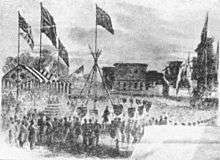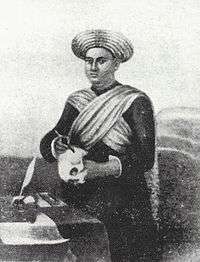Madhusudan Gupta
| Madhusudan Gupta মধুসূদন গুপ্ত | |
|---|---|
|
Pandit Madhusudan Gupta, oil on canvas by S.C. Belnos | |
| Born |
1800 Baidyabati, Hooghly Bengal, British India |
| Died |
15 November 1856 (aged 56) Kolkata, Bengal, British India |
| Cause of death | Diabetic septicemia |
| Nationality | British India |
| Occupation | Doctor |
| Known for | Carrying out the first human dissection in modern India and Asia |
| Children | Gopal Chandra Gupta |
| Parent(s) | Balaram Gupta |
Pandit Madhusudan Gupta (Bengali: মধুসূদন গুপ্ত) (1800 – 15 November 1856) was an Indian doctor and the first Indian trained in Western medicine to dissect a human corpse.[1] When the Medical College was set up in Kolkata, Gupta, broke prevalent social taboos and came forward to dissect human corpse. On 28 October 1836, Gupta became the first Indian to dissect a corpse. He was assisted by Raj Krishna Dey, Umacharan Sett, Dwarkanath Gooptu, and Nabin Chandra Mitra, students of the Medical College. The British East India Company administration honoured him by firing guns from the Fort William. It should be noted that ancient Indian sages such as the legendary surgeon Sushruta had almost certainly performed human autopsies to gain their knowledge of the human body. However, Dr. Madhusudan Gupta was the first Indian to do it as a practitioner of modern Western medicine. [2]
Early life
Gupta came from a Baidya family, who were practitioners of Ayurveda by tradition. He was born to Balaram Gupta in Baidyabati, Hooghly sometime in the year 1800. After completing his school, he took admission in Sanskrit College. He was a student in the Baidyak discipline.
Career
In 1830, he was appointed a professor at the Sanskrit College, replacing Khudiram Visharad, which created a ripple among the student community.

In 1835, the Medical College was set up. The Baidyak discipline was discontinued at the Sanskrit College and Gupta joined Medical College as an assistant teacher. He studied Western medicine along with the students and passed in 1840. In 1845, he became the Superintendent of the Hindusthani medium. In 1848, he was promoted to a first class sub-assistant surgeon. In 1852, the Bengali medium was opened at the Medical College for the first time. Gupta took charge as the Superintendent of the Bengali medium.
Gupta had significant contribution to the history of Calcutta Medical College (CMC) and hospital. During the prima stage of medical college, Indian students were not coming to join the course partly because they were from aristocratic Indian families who had disdain for surgery (reluctant to touch the dead body) and partly because the Ayurvedic and Unani systems of medicine were popular at that time. He was a Sanskrit scholar and Ayurvedic doctor and he did proclaim that he will dissect the dead body and that created waves among the people and after that many came to join the medical education at CMC. The British government fired 50 cannon shot to honour him.[3][4] It is difficult to conceive that 50 gun-salutes were made. Because there was rumour of "cutting up a kid" and the college gates were closed to prevent encroachment.[5] The government was happy because they broke past the custom thought prevailing there to some extent which in fact went against "The Native Medical Institution (NMI)" which was practicing Ayurvedic and Unani medicine culture. He was one among the first batch of students passed from the CMC. He did not pass in the first batch of CMC graduates. Moreover, R Havlock Charles dismises Madhusudan's role as the first dissector.[6] Madhusudan's role may be viewed as one of the first internalizers of modern anatomical education who acted as the agency for the Company's education.
Books
- Anatomy arthat Sharir Vidya in Bengali
- Translated London Pharmacopoeia in Bengali
- Translated Anatomist Vade Mecum in Sanskrit
References
- ↑ Sengupta, Subhodh Chandra; Basu, Anjali, eds. (January 2002). "মধুসূদন গুপ্ত" [Madhusudan Gupta]. Samsad Bangali Charitabhidhan (Bibliographical Dictionary) (in Bengali). Volume 1 (4th ed.). Kolkata: Shishu Sahitya Samsad. pp. 392–393. ISBN 81-85626-65-0.
- ↑ Dutta, Krishna (2003). Calcutta: A Cultural and Literary History. Signal Books. p. 202. ISBN 1902669592. Retrieved April 14, 2012.
- ↑ Bhattacharya, Jayanta (10 November 2011). "The first dissection controversy: introduction to anatomical education in Bengal and British India" (PDF). Current Science. Current Science Association. 101 (9): 1228–1231. Retrieved April 14, 2012.
- ↑ Arnold, David (1993). Colonizing the Body: State Medicine and Epidemic Disease in Nineteenth-Century India. University of California Press. p. 6. ISBN 0520082958. Retrieved April 14, 2012.
- ↑ George Smith, The life of Alexander Duff, New York: A. C. Armstrong % Sons, 1879, Vol. I, pp. 217-218
- ↑ R. Havleock Charles, "The Progress of the Teaching of Human Anatomy in Northern India," British Medical Journal, 30 September 1899, pp. 841-844.
7. Nath Dr Sankar Kumar, (2014), '"Kolkata Medical College-r Gorar Katha O Pandit Madhusudan Gupta"', Sahitya Samsad,Kolkata
- Bose, Debasis (1994). "Madhusudan Gupta" (PDF). Indian Journal of History of Science. 29 (1): 31–41. Retrieved 2 December 2013.
